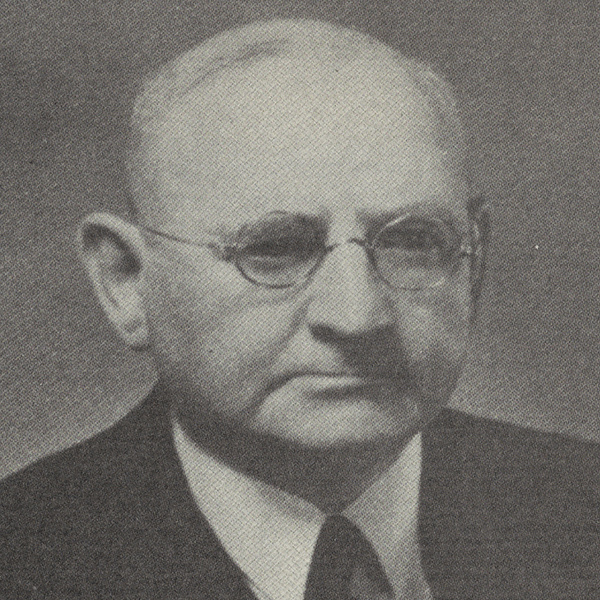Businessperson who fed New York’s hungry.
Wilhelm Loewenstein (1874-1938)
Wilhelm Loewenstein, a German immigrant who deftly blended the world of the merchant with the world of arts, devised one of the most unusual bequests ever administered by The New York Community Trust. A gourmet who never had a hungry day in his comfortable life, Wilhelm astonished his family by asking that income from his residuary estate be used to set up a cafeteria in New York where poor people could eat virtually for free. He invited any orderly person, regardless of race, ethnicity, or religion, and specified that the food be hot and plentiful, and the service be courteous, with no questions asked.
The bequest revealed Wilhelm to be a complex man, who kept his feelings to himself and managed to lead several complementary lives.
First there was Wilhelm Loewenstein the businessman. He was born in 1874 in a gracious mansion in Ellwangen, in southwest Germany, where his father was a well-to-do lawyer. One of 13 children, he was most influenced by his stepbrother Hermann, who was 10 years older and determined to launch a career in the United States. Hermann started a leather-importing business in New York, Herman Loewenstein Inc. Needing help, he sent for Wilhelm.
Wilhelm, in his teens, was immediately put to work by his taskmaster stepbrother. In the early days of the business, the brothers would leave for their office at 6 a.m. and not quit until 7 p.m. Hermann was extremely careful with money—and frugal with Wilhelm, who never took a weekend off without first clearing it with Hermann. When he traveled to Europe twice a year to buy fine leathers, his daily schedule was set up by his stepbrother, who, to make sure Wilhelm did not loiter enroute, would send wires to the foreign firms he was to contact.
Despite the demanding business regimen enforced by Hermann, Wilhelm found time for other interests. There was Wilhelm the scholar. He was a superb linguist who was fluent in eight languages. He could write, read, and speak French, Spanish, Italian, Portuguese, English, and German and spoke Swedish and Russian. He has a scholarly interest in language and literature and prided himself on being letter perfect in his transactions during his travels.
His main task for the firm was buying leathers abroad, and he frequented Europe, and Central and South America. One month, he might be driving his Cadillac through Germany; another month crossing the Andes on a mule. He loved to travel, often accompanied by a niece (he never married), and he embraced his travel experiences with good humor. He once took his passport and substituted a photo of a dog from a Delacroix painting for his own photograph—and observed the reactions of customs officers in different countries. The Swiss were not amused; the French found it hilarious.
Finally, there was Loewenstein the musician and man of the arts. As a youth, he had wanted to be a violinist, and throughout his life, he practiced on his Guarnerius. Among his fondest possessions were his records. Every Friday when he was in New York, he would invite a half-dozen friends of similar tastes to dinner at his apartment in the Hotel Lafayette, where he lived for more than 30 years. After a meal and excellent wines, they would listen for hours to his records. No one was invited who was not strictly attentive to these concerts—generally classical music. (He detested jazz but tolerated a few dance records to placate his nieces.) A frequent opera- and concert-goer, he also donated generously to symphony orchestras, and, when abroad, always tried to schedule some time at the Richard Wagner festival in Bayreuth, Germany.
His interest in art was mostly channeled through his friendships with the German illustrator Karl Stirner and the eccentric “art detective” Richard Goetz, who specialized in ferreting out masterpieces languishing in European junk shops, garrets, and small galleries. With his knowing eye, Goetz “discovered” numerous overlooked paintings, including Tintoretto’s “Lucretia and Tarquinius” and El Greco’s “Portrait of Saint Louis.” Indirectly, and vicariously, many of Goetz’s finds were attributable to Wilhelm Loewenstein, for he had subsidized Goetz during difficult periods in the collector’s somewhat bizarre life.
He was 63. Despite his privileged upbringing, Wilhelm was sensitive to the plight of the poor. While his family never knew it, his friends were aware that during the Great Depression, he was moved by the misery around him in Manhattan. His interests and generosity were aimed at the Salvation Army, education for African Americans, Jewish philanthropies, and conditions in the city’s prisons and hospitals.
After a seven-month illness, Wilhelm Loewenstein died on January 7, 1938. In 1940, The New York Community Trust arranged with the Salvation Army to administer his bequest by establishing the Loewenstein Memorial Cafeteria at 535 W. 48th Street. At its peak, the cafeteria served 300 meals a day, and many more on holidays. In the mid-1970s, with a variety of government-supported food programs in place, the cafeteria was closed. Since then, grants from the Loewenstein Fund have provided for the support of health and welfare in New York City.
